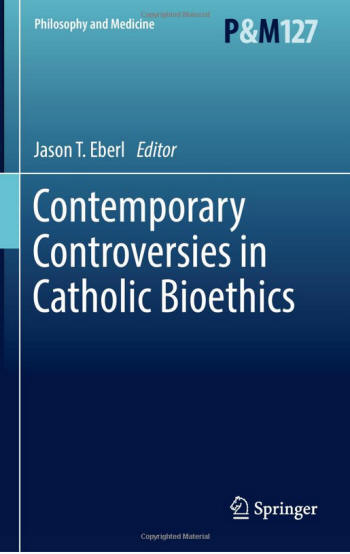Book Review
Contemporary Controversies
In Catholic Bioethics
Jason T Eberl, Editor
Springer (10 August 2017)
ISBN:
978-3319557649
 This
book proved of great interest. Critical issues are debated from a Catholic
perspective by experts in ethics who reach different conclusions. I will
examine three such debates.
This
book proved of great interest. Critical issues are debated from a Catholic
perspective by experts in ethics who reach different conclusions. I will
examine three such debates.
The first involves Jodie and Mary, conjoined twins who shared an aorta. Separation meant the death of the weaker twin, Mary, and survival of the stronger, Jodie. Was the separation justified? Yes, says Christopher Kaczor. No, says Helen Watt.
What matters, according to Kaczor, is the intention. For proponents of the New Natural Law, intention is narrowly defined. If I intend to go jogging, I do not intend to sweat. Perspiration is an unintended side effect. In contrast, for proponents of Classical Natural Law, intentions cannot be limited to the effects chosen. If I go jogging, I surely intend to sweat. On the narrow view, the death of Mary is not intended. It is a foreseen side effect. Interestingly, it is suggested that her death is not intended even on the broad view. For example, the surgical removal of an Ectopic pregnancy is not intentional killing in the Catholic tradition. Nor is the death of Mary. Both interventions are targeted remedies of defective biological functioning. So even on the broad view, the death of Mary is a case of letting die, not intentional killing.
Dr Watt responds by noting that the non-therapeutic invasion of Mary is difficult to justify. It is one thing to do heart surgery on an unshared heart. But it is morally quite different to give a shared heart to one twin alone without intending the death of the other. Both twins have rights concerning their shared territory. The bodily rights of human beings do not lapse even when one person is a danger to the other. Mary is a non-aggressor and should not be subject to bodily invasion of a gravely harmful kind. The bodily rights of one person cannot be violated in order to save the life of another.
The second debate concerns the prescription of Levonorgestrel (LNG) to victims of rape. In Catholic teaching, a woman who has been raped has a right to defend herself against a potential conception if there is no evidence that conception has occurred. She can be treated with medication that prevents ovulation and fertilization. It is morally wrong to initiate treatment that has the intention of destroying a fertilized ovum. Peter Cataldo argues in favour of administering LNG while Thomas Davis argues against.
Cataldo notes that moral certitude does not require the greatest probable knowledge possible in the circumstances. Even the LNG surge test only provides probable knowledge. The classic case of taking the safer course does not apply because here we have no evidence that a human being has been harmed. The Catholic moral tradition has held that we are not responsible for the consequences of actions that cannot be reasonably forseen
In contrast, Davis argues that while it had been maintained by proponents of LNG that it works primarily by suppressing ovulation, new research indicates that this is not the case. The typical mode of action is unknown and this creates a dilemma. While no one claims absolute moral certainty is required to act, something more than mere possibility is needed in view of the gravity of the matter at hand. The burden of proof rests with proponents of LNG administration. The abortifacient effect, far from being ruled out, seems quite likely. Might double effect reasoning come into play? No. Double effect reasoning requires at least two anticipated effects: one good, the other evil. This is not the case with LNG. In any given administration, there is only one effect: it is either abortive or it is not. In Catholic tradition, in case of doubt, LNG administration is prohibited.
The third debate concerns whether a HIV positive husband can use a condom when having sexual intercourse with his wife. No, says Christopher Tollefsen. Yes, says William Murphy.
Tollefsen argues that there are such things as moral acts that are intrinsically wrong. For example, intentional killing of an innocent human being. The crucial question is: has the agent intended the bad effect? In order to be morally good, sexual acts need to be marital. In other words, they need to be not only open to life but they also need to be unitive. It is true that the HIV positive husband does not have a contraceptive intention. His intention is disease prevention. However, the very use of a condom makes the act non-marital.
William Murphy cites the work of Martin Rhonheimer, a proponent of condom use in such cases, to justify his view. Whereas Rhonheimer argued from the perspective of the acting person, his opponents argued from a physical perspective. Condom use is directed at disease prevention. Contraception is not the intention. There are other instances when condom use does not make moral act any worse. For example, condom use with a prostitute does not change the kind of moral act it is. Opponents of condom use focus unduly on the physical act: on the deposition of sperm in the vagina. When married couples engage in intercourse even when a condom is used, the act is marital in essence.
There can be no doubting the complexities involved in these ethical debates. We can be grateful that they have been so well argued in these pages.
Reviewed by Dr Pravin Thevathasan
